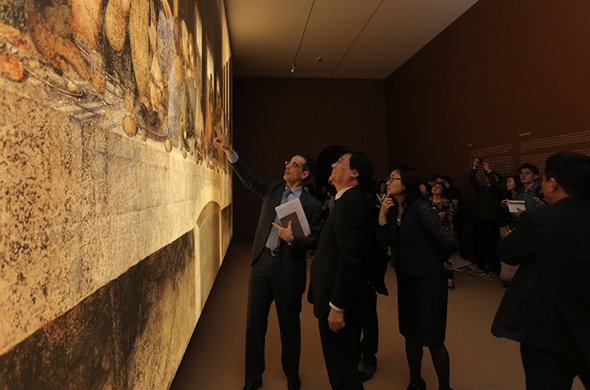
2019 witnesses the 500th anniversary of the death of the Italian Renaissance master Leonardo da Vinci, various forms of commemoration will be held all over the world. On April 16, 2019, the Art Museum of the Central Academy of Fine Arts and the Cultural Center of the Italian Embassy in China jointly presented the cultural promotional art project “The Art of Leonardo: Opera Omnia” at CAFA Art Museum. As one of a series of activities commemorating Leonardo da Vinci in China, the exhibition presents high-quality reproduction of 17 pieces of Leonardo da Vinci’s classics collected by the world’s top museums such as the Louvre, the Uffizi Gallery and the Vatican Museum, through high-definition photography and simulation of the original large output in technology. The exhibition focuses on the most important artistic legacy from Leonardo da Vinci. In order to optimize the effect of the exhibition, Zhu Pei, Dean of the School of Architecture at the Central Academy of Fine Arts, specially designed the space for the exhibition.
Leonardo da Vinci is a giant of the Renaissance and a versatile genius, as he was not only an expert in the fields of painting, sculpture and architecture, but also in the fields of mathematics, mechanics, medicine, botany, anatomy, geology, optics, etc. He has made great contributions to each area and he was a model in combining art with science. Known for his outstanding achievements in painting, he is ranked among the most outstanding representative painters of the Renaissance. For Leonardo da Vinci, painting is not just about depicting a thing, but also about the intellectual activity of understanding the world like a huge machine by imitating and interpreting the essence of nature. The paintings left by Leonardo da Vinci are very few and they are scattered in museums all over the world. Therefore, it is impossible for the audience to see a series of Leonardo da Vinci’s paintings in one space. With high-definition output technology, the exhibition preserves the texture of the work and brings together the classics of Leonardo da Vinci in a brand new way, making this impossible encounter possible.
As for the theme of the exhibition, as Gao Hong, Secretary of the Party Committee of the Central Academy of Fine Arts, further explained in his opening speech: First, we encounter profound and knowledgeable masters of art and science in the history of human civilization; second, we encounter the peak of human wisdom, Leonardo da Vinci believes that the highest pleasure is the joy of comprehension and he combines the human comprehension of art with science as they are both tools and purposes; third, we have the opportunity to explore mysteries. Leonardo da Vinci’s story of art is well-known and his works show a deep knowledge of people and the world. The exhibition provides an opportunity to get close to the works to explore the mystery of human wisdom and civilization. Franco Amadei, the Cultural Counselor of the Italian Embassy in China, delivered a congratulatory speech from the Italian Ambassador Ettore Francesco SEQUI to China, this exhibition is the result of the joint efforts by the governments and cultural institutions of China and Italy. This art education promotion project further enriches the “Silk Road of Wisdom” between the two countries. The content has deepened the friendship between the two countries and they hope that this “Silk Road of Wisdom” will renew its vitality in the future.
There are few masterpieces of Leonardo da Vinci that have been handed down, the Italian scholar Antonio Paulucci found through research that the number of works that he can see today is very small, even less than twenty. Some documented paintings have been lost; some works have not been completed; others have been damaged by technical defects during the creation process. The 17 works presented in this exhibition run through all stages of Leonardo da Vinci’s creative career, and visitors can also trace the artist's life through his classic works. The exhibition will remain on view until May 23.
Text (CN) by Zhang Wenzhi, edited (EN) by Sue/CAFA ART INFO
Photo by Hu Sichen/CAFA ART INFO
The Last Supper
(Cenacle)
Wall painting
460×880cm
Refectory of Santa Maria delle Grazie, Milan
Finished in 1498
When standing before Leonardo’s Milanese Last Supper, the first thing we must understand is the extremely diminished state with which this masterpiece has reached us. Instead of using the Florentine “buon fresco” methods, in order to obtain particularly suggestive naturalistic effects, Leonardo used a particular technique that envisaged the use of tempera mixed with oil. This led to a process of progressive degradation that has obliged generations of restorers to intervene, from the masters of the eighteenth century to the modern Cavenaghi and Pelliccioli, up to Pinin Brambilla, who worked on the last major intervention between the 1980s and 90s. In fact, it is fair to say that between fallen paint, additions and retouches, perhaps less than 50% of Leonardo’s original painting is present on the wall of Santa Maria delle Grazie.
The Annunciation
Painting on panel
98×217cm
Uffizi Gallery, Florence
c.1470
The defects in the perspective, which can be justified by the young painter’s relative inexperience, have often been noted by critics, even if they do not affect the figures’ immersion in a transparent and luminous atmosphere that opens towards remote mountains and a city. The recent restoration by Alfio Del Serra has brought out the extraordinary brilliance of the pictorial rendering. The most unforgettable detail in the painting is the living carpet on which the flying angel lands. What Leonardo painted in the foreground is vibrating and elastic nature, minutely studied in every detail: a foreshadowing of the Maestro’s inexhaustible research on the wonders of the living nature of plants and animals.
Ginevra de’Benci
Painting on panel
38.8×36.7cm
National Gallery of Art, Washington
c.1475
This painting was first in the Lichtenstein collection in Vienna and is the work of a young Leonardo, not yet twenty-five and still gravitating around Andrea del Verrocchio’s workshop. This small and precious painting is a repertoire of onomastic symbols and praises to the girl shown here. The thorny vegetation spreading out behind her face is a juniper bush, a well-wishing plant and also allusive to the woman’s name. In the background, three plants are intertwined to form a coat of arms: a twig of juniper in the centre, a laurel frond on the left and a palm on the right, respectively symbols of glory (laurel) and the virtue (the palm). Commentary of the symbolic trophy can be seen in the scroll in Latin declaring “virtutem forma decorat” (Virtue Adorns Beauty). The painting features a very find pictorial technique that renders that in this youthful phase, Leonardo borrowed from Flemish painting, especially that of Van Eyck, who was certainly included in the Florentine magnates’ collections (Gombrich, 1964; Salvini, 1984).
Madonna and Child (Madonna of the Carnation)
Painting on panel
62×47.5cm
Alte Pinacotek, Munichch
c. 1473
The Madonna is depicted in the act of offering a red carnation to her naked Child, who welcomes it with festive impetuosity. A vast, bright mountain landscape made of blue peaks and woods can be seen beyond the open loggia. This is perhaps the most Florentine and “Verrocchio-like” of Leonardo’s paintings. This is why the painting’s author, today firmly and universally recognised as Leonardo, has long fluctuated between Lorenzo di Credi and Verrocchio himself.
Madonna and Child with Flowers (Benois Madonna)
Painting on panel transported on canvas
48×31cm
Hermitage Museum, St. Petersburg
c. 1480-1481
The painting suffered greatly as a result of its transport on canvas, and its conservation conditions are certainly not the best. A tender circle of affections links the Madonna to her child, and we will find this idea again in the cartoon with Saint Anne, the Virgin and Child in London. The Madonnas of the Florentine period of Raphael (Madonna of the Goldfinch, La Belle Jardinière) owe a great deal to works like this. It is possible (Marani, 1989) that the painting was conceived and set up in Florence before Leonardo left for Milan and then concluded in Lombardy.
Adoration of the Magi
Panel drawn with charcoal, painting in ink watercolor and partly in oil
243×246cm
Uffizi Gallery, Florence
c. 1481
Leonardo imagined a wave of humans unfurling at the feet of the Virgin, arranged around her in a circular pattern, like an aquatic whirlpool with the centre of attraction and the rest being the Child sitting in the lap of his Mother. The background of the painting, still sketched with the graphic fluency and executive speed of a notebook, is full of various episodes. On the right there are scenes of horses and men confronting each other in combat (a germinal idea for the future fresco for the Battle of Anghiari in Palazzo Vecchio in Florence). On the left three are architectures which are partly in ruins and partly in the process of restoration and reconstruction. According to recent studies by Antonio Natali (2002, 2016) the theme is Isaiah’s prophecies (Isaiah 7, 14 and Isaiah 60, 4, 6-7) on the coming of Christ the Savior, destined to bring peach to earth and build the new world on the ruins of the old.
St Jerome in the Wilderness
Painted on panel
103×75cm
Vatican Art Gallery, Rome
c. 1480-1482
This unfinished panel depicts St Jerome who, on his knees with a partially exposed body, is doing penance in the desert by beating his chests with the stone he holds in his right hand. In front of him is the lion, his usual iconographic symbol. The hermit saint is surrounded by rocks looming over him, which multiply while fading into the distant horizon. We know nothing of the painting’s original destination, nor do we know why the Maestro left it unfinished. The strong naturalistic characteristic tones of black and ochre and the fast, cursive execution technique suggest a date near or shortly after the Adoration of the Magi in the Uffizi.
Lady with an Ermine (Cecilia Gallerani)
Oil on panel
54.8×40.3cm
Czartoryski Collection, Krakow
c. 1488-89
A very beautiful and very young woman of high social rank is depicted in the painting, as can be seen by her hairstyle, clothes, jewellery and the fact that she does not look at us but turns her head slightly, as if the presence or speech of someone have suddenly both distracted and interested her. There is something passionate and restless in the sudden movement of this woman who “breaks” the pose with tender vehemence. She holds an ermine in her arms: a small, lively, vibrant and cruel beast. The beast caressed by the woman must be scrutinised from up close: the electric glow of its white fur and the fierce grace of its triangular muzzle illustrate Leonardo’s greatness in studying and depicting living nature.
La Belle Ferronière
Painting on panel
63×45cm
Louvre, Paris
c. 1495-1500
The optical subtlety and total camouflage (certainly reminiscent of examples from Flemish painting and perhaps Antonello da Messina) with which Leonardo describes the shapes and splendour of the jewellery, the tactile consistency of the clothes, the bright and smooth beauty of this young woman are extraordinary. Leonardo conceived his portrait as a sculpture, almost inviting us to walk around it (Kemp, 1988).
Portrait of a Musician
Painting on panel
44.7×32cm
Ambrosiana Art Gallery, Milan
c. 1488-89
The attribution to Leonardo which is universally accepted today came about with some difficulty. Some thought it was a collaborative work begun and set up by Leonardo, then finished by some of his students such as De Predis or Boltraffio. Recent scientific analyses have shown that the hand of the figure holding the scroll was added at a later time with different pigments and binders.
Mona Lisa
Painting on panel
77×53cm
Louvre, Paris
c. 1501-03
This is one of the most famous painting in the world, a true icon of the universal tourist imaginary, yet there is very little that is certain about this work of art. Executed with a perfect technique for ultra-fine overlapping layers, the Portrait of Mona Lisa has fascinated generations of critics and writers for her enigmatic smile and her immersion in vast, vibrant nature with infinite luminous thrills.
The Virgin of the Rocks
Painting on panel
199×122cm
Louvre, Paris
c. 1483-46
The iconographic theme of the painting is the legendary story of the meeting of Christ the child and Saint John. The Madonna embraces Jesus with her right hand and hold him to herself, while he faces Saint John. The angel indicates Christ the Savior with his right hand. The episode is set in a landscape of rocks with lush vegetation, crossed by contrasting lights. Remote mountain ranges emerge from open gaps in the geological landscape, There are sill remnants of Florence, especially in the pointing angel, in this painting that is placed at the centre of Leonardo’s Milanese period.
Head of a Woman (la Scapigliata)
Umber and white on panel
27.7×21cm
National Art Gallery, Parma
c. 1500
This is one of Leonardo’s most mysterious and controversial works. It has always been known by the name La Scapigliata for the girl’s hair tussled by the wind, ans we know that the painting first came to the Academy of Fine Arts in Parma in 1839.
The Virgin and Child with Saint Anne
Painting on panel
168×130cm
Louvre, Paris
c. 1513
Leonardo had long meditated on the theme o f the Holy Family and in particular the women (grandmother Anna, mother Mary) who watch baby Jesus with love and trepidation. Leonardo expressed his first thoughts on the subjects around 1500 in a cartoon with The Virgin and Child with St Anne and St John the Baptist, currently at the National Gallery in London. The iconography of the Holy Family undergoes a further evolution in this painting. St John is not depicted directly, but as a lamb: the symbolic figure of the sacrifice of Jesus (the lamb of God who takes the sins of the world away). Baby Jesus embraces the lamb, almost prefiguring his destiny as a sacrificed victim. The Madonna is aware of this, holding her son close to her as if to distance him from his fate. But St Anne, who is a figure of the Church, watches over the sacrifice of Jesus and with that, the redemption of the human race.
Bacchus
Panel transferred on canvas
177×115cm
Louvre, Paris
c. 1510-1513
The iconographic mutation (from Bacchus to St John the Baptist in the desert) may have taken place while Leonardo was still alive. Carlo Pedretti (1973) believes, and this belief is shared by much of contemporary criticism (Marani, 1989), that it should be work in part signed by Leonardo, as he set it up and then it was completed by students.
Saint John the Baptist
Painting on panel
69×57cm
Louvre, Paris
c. 1513-1516
Only three quarters of St John is depicted, with his right hand extended forward to indicate upward, his face tilted to the left, with a spiral movement in the figure totally immersed in the atmospheric medium. The scientific analyses carried out on the painting (radiographs, reflectography) have demonstrated a pictorial condition of absolute technical excellence based on very light glazing, almost without a trace of brush, with minimal pictorial material.
Courtesy of the organizer.



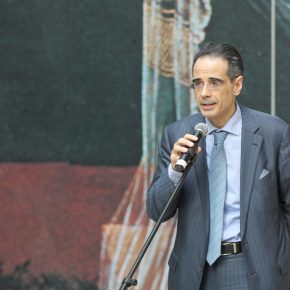
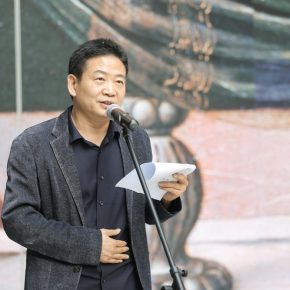
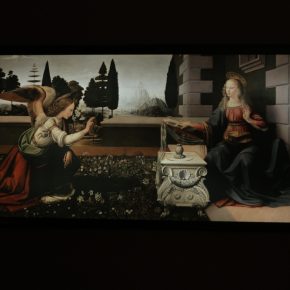
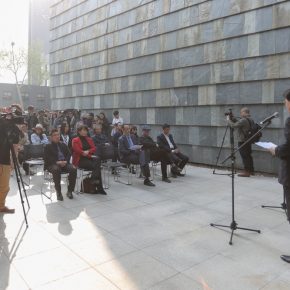
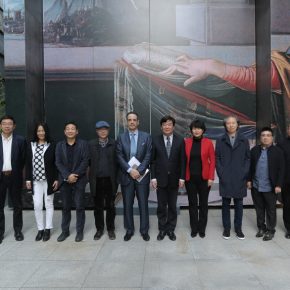

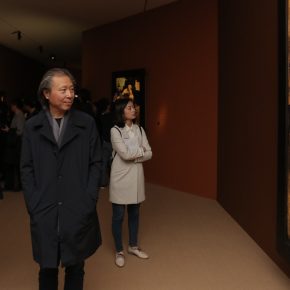
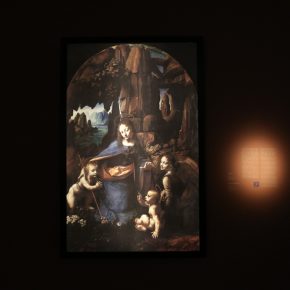
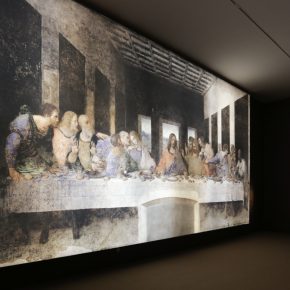
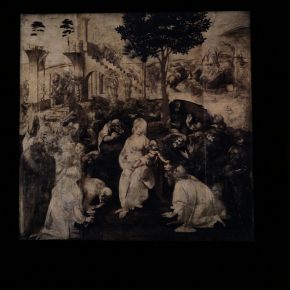
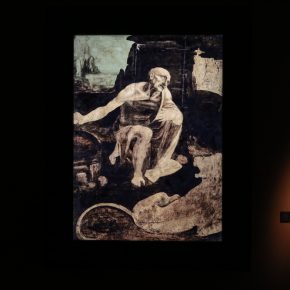
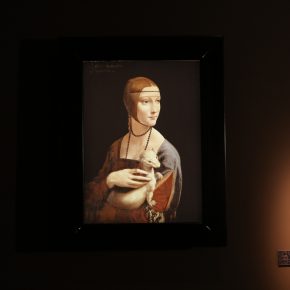
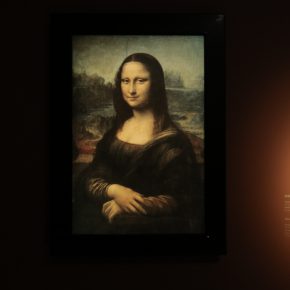
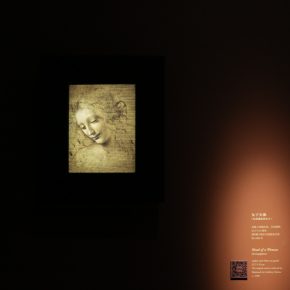
木板油画-54.8×40.3cm-克拉科夫恰尔托雷斯基博物馆藏-约1488-1489-年-290x290.jpg)
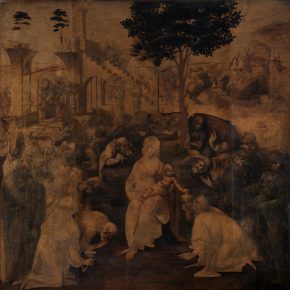
-木板油画转布面油画-48×31cm-圣彼得堡艾尔米塔什博物馆藏-约1480-1481年-290x290.jpg)
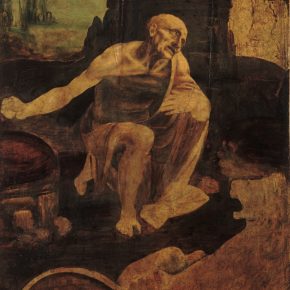
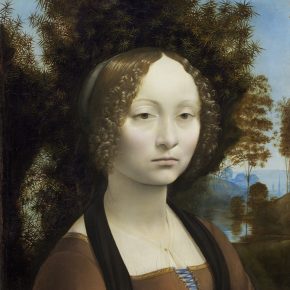
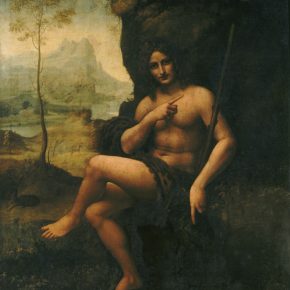
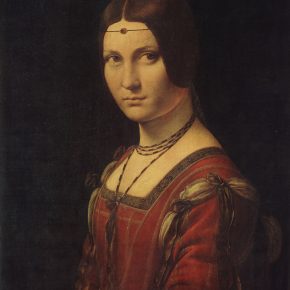
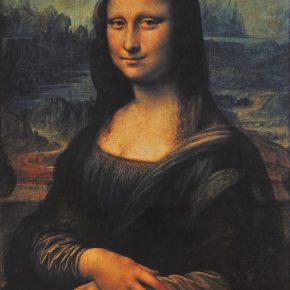
-木板上用棕红色、白色颜料-27.7×21cm-帕尔马国家美术馆-约1500-年-290x290.jpg)
-木板油画-62×47.5cm-慕尼黑古美术馆藏-约1473-年-290x290.jpg)

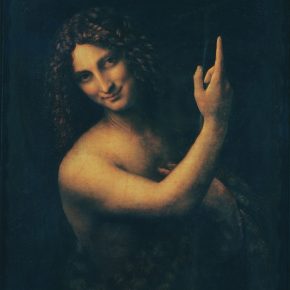
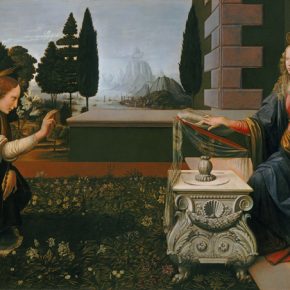
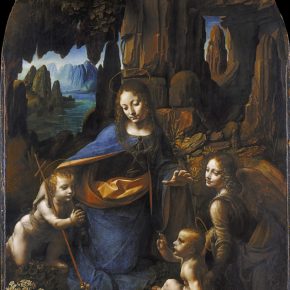
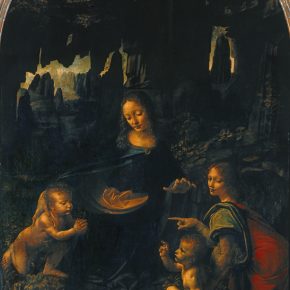
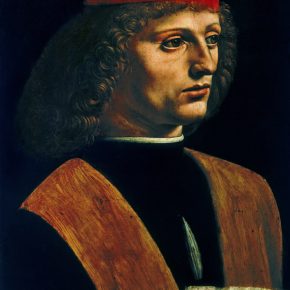
-壁画-460×880cm-米兰圣马利亚感恩教堂餐室-完成于1498-年-290x290.jpg)


























